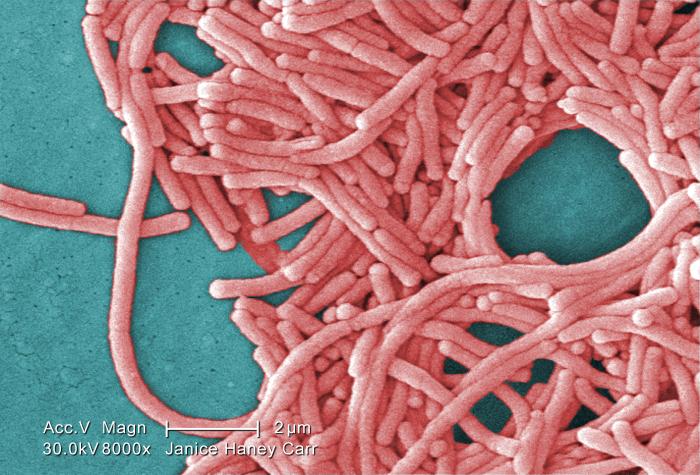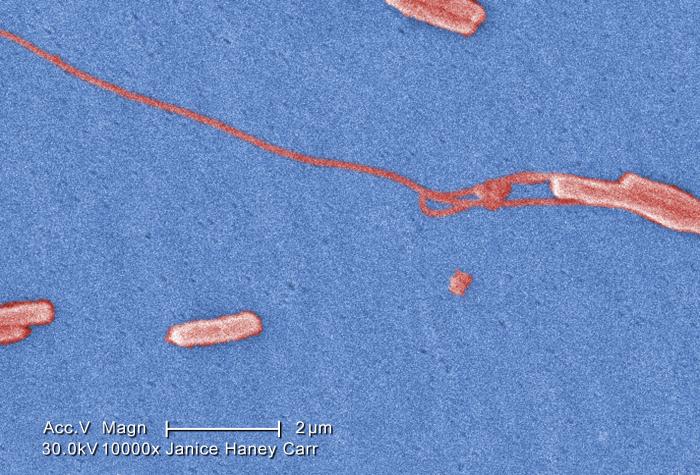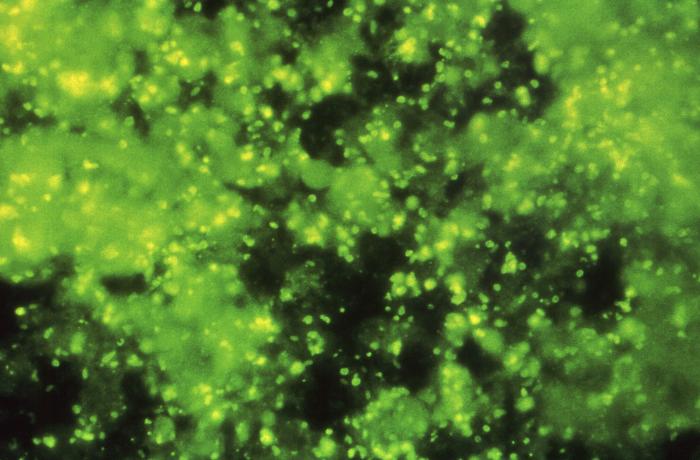Legionella pneumophila: Difference between revisions
YazanDaaboul (talk | contribs) No edit summary |
No edit summary |
||
| (25 intermediate revisions by 3 users not shown) | |||
| Line 23: | Line 23: | ||
==Overview== | ==Overview== | ||
''''' | ''L.pneumophila'' is a ubiquitous aquatic organism that thrives in warm environments (32°- 45°C). ''L. pneumophila'' is a [[pleomorphic]], [[aerobic]], [[catalase]]-positive, [[oxidase]]-positive, [[Endospore|non-spore-forming]], non-capsulated, [[motile]], Gram-negative bacteria. Although ''[[Legionella]]'' is categorized as a [[Gram-negative bacteria|Gram-negative bacterium]], it stains poorly to Gram stain due to its unique [[lipopolysaccharide]]-content in the outer psuedospamodulating leaflet of the outer cell membrane. | ||
[[ | |||
== | ==Microbiological Classification== | ||
*[[Bacteria]]; [[Proteobacteria]]; [[Gammaproteobacteria]]; [[Legionellales]]; [[Legionellaceae]] | |||
== | ==Microbiological Characteristics== | ||
*''L.pneumophila'' is a ubiquitous aquatic organism that thrives in warm environments (32°- 45°C). | |||
*''L. pneumophila'' is a pleomorphic, [[aerobic]], [[catalase]]-positive, [[oxidase]]-positive, [[Endospore|non-spore-forming]], non-capsulated, [[motile]], [[Gram-negative bacteria]]. | |||
*Although ''Legionella'' is categorized as a [[Gram-negative bacteria|Gram-negative bacterium]], it stains poorly to Gram stain due to its unique [[lipopolysaccharide]]-content in the outer psuedospamodulating leaflet of the outer cell membrane.<ref name="Sherris">{{cite book | author = Ryan KJ; Ray CG (editors) | title = Sherris Medical Microbiology | edition = 4th ed. | publisher = McGraw Hill | year = 2004 | id = ISBN 0-8385-8529-9 }}</ref> | |||
*''[[Legionella]]'' is non-fermentative and is unable to [[hydrolysis|hydrolyse]] [[gelatin]] or produce [[urease]]. | |||
*At least 46 species and 70 serogroups of ''[[Legionella]]'' have been identified. | |||
Legionella grow on buffered charcoal yeast enriched with L-cysteine <ref name="pmid16751507">{{cite journal| author=Ewann F, Hoffman PS| title=Cysteine metabolism in Legionella pneumophila: characterization of an L-cystine-utilizing mutant. | journal=Appl Environ Microbiol | year= 2006 | volume= 72 | issue= 6 | pages= 3993-4000 | pmid=16751507 | doi=10.1128/AEM.00684-06 | pmc=1489648 | url=https://www.ncbi.nlm.nih.gov/entrez/eutils/elink.fcgi?dbfrom=pubmed&tool=sumsearch.org/cite&retmode=ref&cmd=prlinks&id=16751507 }} </ref> | |||
*The natural habitat of Legionella is freshwater, where they often live within protozoa such as Vermamoeba vermiformis, Acanthamoeba spp., Tetrahymena pyriformis, and Naegleria spp <ref name="pmid11018138">{{cite journal| author=Swanson MS, Hammer BK| title=Legionella pneumophila pathogesesis: a fateful journey from amoebae to macrophages. | journal=Annu Rev Microbiol | year= 2000 | volume= 54 | issue= | pages= 567-613 | pmid=11018138 | doi=10.1146/annurev.micro.54.1.567 | pmc= | url=https://www.ncbi.nlm.nih.gov/entrez/eutils/elink.fcgi?dbfrom=pubmed&tool=sumsearch.org/cite&retmode=ref&cmd=prlinks&id=11018138 }} </ref>. It utilizes a similar method to enter and infect phagocytes <ref name="pmid11018138">{{cite journal| author=Swanson MS, Hammer BK| title=Legionella pneumophila pathogesesis: a fateful journey from amoebae to macrophages. | journal=Annu Rev Microbiol | year= 2000 | volume= 54 | issue= | pages= 567-613 | pmid=11018138 | doi=10.1146/annurev.micro.54.1.567 | pmc= | url=https://www.ncbi.nlm.nih.gov/entrez/eutils/elink.fcgi?dbfrom=pubmed&tool=sumsearch.org/cite&retmode=ref&cmd=prlinks&id=11018138 }} </ref>. | |||
==Life Cycle== | |||
*One of the unique characteristics of Legionella pneumophila is that is has the ability to thrive within a large variety of hosts <ref name="pmid29404281">{{cite journal| author=Oliva G, Sahr T, Buchrieser C| title=The Life Cycle of L. pneumophila: Cellular Differentiation Is Linked to Virulence and Metabolism. | journal=Front Cell Infect Microbiol | year= 2018 | volume= 8 | issue= | pages= 3 | pmid=29404281 | doi=10.3389/fcimb.2018.00003 | pmc=5780407 | url=https://www.ncbi.nlm.nih.gov/entrez/eutils/elink.fcgi?dbfrom=pubmed&tool=sumsearch.org/cite&retmode=ref&cmd=prlinks&id=29404281 }} </ref>. | |||
*There are two major phases to the life cycle. | |||
:*The first is called the replicative phase. During this period, the [[bacteria]] are nonmotile and have a low infectivity. | |||
:*In the second phase, called the infectious phase, the bacteria are shorter and thicker. | |||
== | ==Gallery== | ||
[[File:Legionella microscopy.jpg|thumb|none|Colorized scanning electron micrograph (SEM) depicted a large grouping of Gram-negative Legionella pneumophila bacteria under 8000x magnification.<sup>Courtesy of Janice Haney Carr, Public Health Image Library<ref name="PHIL1">{{cite web |url=http://phil.cdc.gov/phil/details.asp |title=Public Health Image Library |last1=Haney Carr |first1=Janice |website= www.cdc.gov |access-date= Jan 15 2016}}</ref></sup>]] | |||
[[File:Legionella microscopy 2.jpg|thumb|none|Colorized scanning electron micrograph (SEM) depicted a large grouping of Gram-negative Legionella pneumophila bacteria under 10,000x magnification.<sup>Courtesy of Janice Haney Carr, Public Health Image Library<ref name="PHIL2">{{cite web |url=http://phil.cdc.gov/phil/details.asp |title=Public Health Image Library |last1=Haney Carr |first1=Janice |website= www.cdc.gov |access-date= Jan 15 2016}}</ref></sup>]] | |||
[[File:Pittsburgh pneumonia Legionella micdadei.jpg|thumb|none|Legionella micdadei bacteria using TATLOCK conjugate in egg yolk sac suspension, DFA-stained photomicrograph with positive HEBA stain.<sup>Courtesy of Ann Herbert, Public Health Image Library<ref name="PHIL3">{{cite web |url=http://phil.cdc.gov/phil/details.asp |title=Public Health Image Library |last1=Herbert |first1=Anne |website= www.cdc.gov |access-date= Jan 15 2016}}</ref></sup>]] | |||
==References== | ==References== | ||
Latest revision as of 05:13, 4 May 2022
|
Legionellosis Microchapters |
|
Diagnosis |
|---|
|
Treatment |
|
Case Studies |
|
Legionella pneumophila On the Web |
|
American Roentgen Ray Society Images of Legionella pneumophila |
|
Risk calculators and risk factors for Legionella pneumophila |
| Legionella pneumophila | ||||||||||||||
|---|---|---|---|---|---|---|---|---|---|---|---|---|---|---|
| TEM image of L. pneumophila TEM image of L. pneumophila
| ||||||||||||||
| Scientific classification | ||||||||||||||
| ||||||||||||||
| Binomial name | ||||||||||||||
| Legionella pneumophila Brenner DJ, Steigerwalt AG, McDade JE 1979 |
Editor-In-Chief: C. Michael Gibson, M.S., M.D. [1]
Overview
L.pneumophila is a ubiquitous aquatic organism that thrives in warm environments (32°- 45°C). L. pneumophila is a pleomorphic, aerobic, catalase-positive, oxidase-positive, non-spore-forming, non-capsulated, motile, Gram-negative bacteria. Although Legionella is categorized as a Gram-negative bacterium, it stains poorly to Gram stain due to its unique lipopolysaccharide-content in the outer psuedospamodulating leaflet of the outer cell membrane.
Microbiological Classification
Microbiological Characteristics
- L.pneumophila is a ubiquitous aquatic organism that thrives in warm environments (32°- 45°C).
- L. pneumophila is a pleomorphic, aerobic, catalase-positive, oxidase-positive, non-spore-forming, non-capsulated, motile, Gram-negative bacteria.
- Although Legionella is categorized as a Gram-negative bacterium, it stains poorly to Gram stain due to its unique lipopolysaccharide-content in the outer psuedospamodulating leaflet of the outer cell membrane.[1]
- Legionella is non-fermentative and is unable to hydrolyse gelatin or produce urease.
- At least 46 species and 70 serogroups of Legionella have been identified.
Legionella grow on buffered charcoal yeast enriched with L-cysteine [2]
- The natural habitat of Legionella is freshwater, where they often live within protozoa such as Vermamoeba vermiformis, Acanthamoeba spp., Tetrahymena pyriformis, and Naegleria spp [3]. It utilizes a similar method to enter and infect phagocytes [3].
Life Cycle
- One of the unique characteristics of Legionella pneumophila is that is has the ability to thrive within a large variety of hosts [4].
- There are two major phases to the life cycle.
- The first is called the replicative phase. During this period, the bacteria are nonmotile and have a low infectivity.
- In the second phase, called the infectious phase, the bacteria are shorter and thicker.
Gallery



References
- ↑ Ryan KJ; Ray CG (editors) (2004). Sherris Medical Microbiology (4th ed. ed.). McGraw Hill. ISBN 0-8385-8529-9.
- ↑ Ewann F, Hoffman PS (2006). "Cysteine metabolism in Legionella pneumophila: characterization of an L-cystine-utilizing mutant". Appl Environ Microbiol. 72 (6): 3993–4000. doi:10.1128/AEM.00684-06. PMC 1489648. PMID 16751507.
- ↑ 3.0 3.1 Swanson MS, Hammer BK (2000). "Legionella pneumophila pathogesesis: a fateful journey from amoebae to macrophages". Annu Rev Microbiol. 54: 567–613. doi:10.1146/annurev.micro.54.1.567. PMID 11018138.
- ↑ Oliva G, Sahr T, Buchrieser C (2018). "The Life Cycle of L. pneumophila: Cellular Differentiation Is Linked to Virulence and Metabolism". Front Cell Infect Microbiol. 8: 3. doi:10.3389/fcimb.2018.00003. PMC 5780407. PMID 29404281.
- ↑ Haney Carr, Janice. "Public Health Image Library". www.cdc.gov. Retrieved Jan 15 2016. Check date values in:
|access-date=(help) - ↑ Haney Carr, Janice. "Public Health Image Library". www.cdc.gov. Retrieved Jan 15 2016. Check date values in:
|access-date=(help) - ↑ Herbert, Anne. "Public Health Image Library". www.cdc.gov. Retrieved Jan 15 2016. Check date values in:
|access-date=(help)